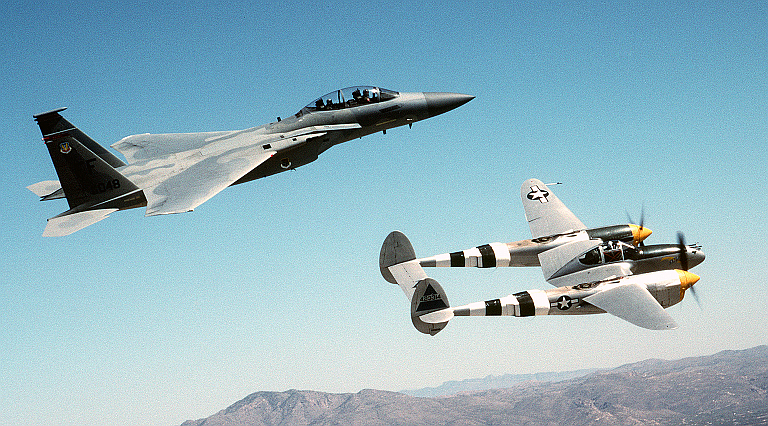During World War II, American airpower was tested on both a tactical and strategic level to gather information, carry soldiers to the battlefield, and engage in aerial combat with the enemy. On September 18, 1947, President Harry S. Truman signed the National Security Act in response to a historical moment demonstrating the need for a strong and independent air force. The legislation created the Air Force as an official military branch of the United States.
On the U.S. Air Force’s 75th birthday, the legacy of the World War II-era aircraft, the P-38 Lightning, was revisited by a USAF release and commemorated for its indelible influence on the F-35 Lightning II.
The unrivalled fifth-generation capabilities of the F-35 Lightning II are on display. USAF release says it is the world’s most sophisticated, deadly, interoperable, and survivable joint strike fighter. The Lightning II proudly continues the heritage of the original Lightning. The parallels between the two aircraft are not in design but rather in the ideology with which the United States constructs fighter planes and the battling spirit of the pilots.
As per the USAF Lightning II program office, the designation “Lightning” is suitable for a military aircraft since Lightning rushes rapidly across the sky and contains electricity that may be fatal if in contact. Like the Lightning II, the Lightning I was capable of almost anything at its height. It was the fastest and highest-flying aircraft of its day.
The P-38 Lightning entered formal service with the United States Army Air Corps in 1940. The aircraft was capable of various missions, including air-to-air combat, dive and skip bombing, night combat, photo-reconnaissance, and cutting-edge radar escort. Its innovative twin-engine design enabled maximum performance and gave it tremendous speed and power. Consequently, the P-38 Lightning swiftly became the preferred fighter throughout the conflict. A German pilot once surrendered to Allied soldiers stationed in Tunisia, North Africa, referring to the P-38 as “Der Gabelschwanz Teufel,” or the “fork-tailed devil,” as proof of the aircraft’s combat prowess.
More than 130,000 worldwide missions were flown by more than 10,000 P-38s, comprising 18 unique versions constructed during World War II and flown throughout that conflict. Pilots of the P-38 shot down more Japanese aircraft than any other fighter, and as reconnaissance aircraft, P-38s collected 90 per cent of the aerial footage taken over Europe. Indeed, World War II was the P-38 Lightning’s testing ground.

On April 18, 1943, maybe the P-38 Lightning’s most renowned mission happened. U.S. intelligence revealed that Admiral Isoroku Yamamoto, the Japanese naval head and architect of the Pearl Harbor assault, was flying to Bougainville Island in the Pacific. Sixteen P-38Gs left Guadalcanal and flew a 1,000-mile round-trip to intercept Yamamoto’s G4M bomber and bring it down on the island below. It marked a pivotal moment in the conflict. Following the interception of the admiral and his entourage, Japanese navy morale plummeted while Allied morale soared. The intercept contributed to the Allied victory in the Pacific. Before being decommissioned by the Air Force in 1949, Lightning I flew for many more years and performed very well in the 1940s.
In 2006, the first F-35 Lightning II was rolled out from a high-security facility in Fort Worth, Texas. The Air Force revealed that the next fifth-generation fighter would be dubbed “Lightning II” after the P-38 Lightning. Similar to the Lightning during World War II, the F-35 is a game-changer in today’s global context, necessitating a vigilant eye on opponents worldwide.
Although the designs of the P-38 Lightning and the F-35 Lightning II are distinct, both aircraft were created to deliver the highest mission-accomplishing capabilities to the fighter pilots. Veteran P-38 and F-35 test pilots agree that the P-38 represented the peak of technical innovation and the greatest inventiveness of its era. The F-35 Lightning II retains the same capabilities as its predecessor. P-38’s stealth, long-range sensors, strong propulsion system, and precise missiles are symbolically perched on the aircraft’s wings.
As the history of the P-38 Lightning lives on in the F-35 Lightning II, there is more than a name or capabilities connection between these two fighters.
P-38 Lightning
The importance of Lockheed’s P-38 Lightning twin-boom fighter during the decisive air battles of World War II has been persistently downplayed throughout the last half-century. Receiving considerably less attention than its single-engined stablemate, the P-51 Mustang, the large twin, fought the most significant air battles of 1943 to 1944 and was instrumental in breaking the back of Axis air power in Germany, the Mediterranean, and the Pacific.
The P-38 excelled in a design characteristic that is essential for waging a strategic air war; its combat radius of almost 700 nautical miles had no equal in either camp.
The P-38 provided long-range escort for heavy bombers; long-range fighter sweeps deep into enemy airspace, and interdiction of surface targets in both the Pacific and the Mediterranean. In the United Kingdom, the P-38 wings first provided long-range escort for the 8th Air Force during a crucial period of the daytime bombing operation, when Luftwaffe strength was at its peak, and American bomber losses were becoming unsustainable. The availability of the P-38 permitted the attack to continue at a time when it may have been dialled down owing to excessive losses.
The Lockheed P-38 was a sophisticated aircraft using revolutionary technology that, through a long and lengthy development period, and was ultimately denied credit for the significance of its role.

jf 17 original name is fc xionlong. Its a mig 21 copy. Its a very outdated chinese plane with high crash rate